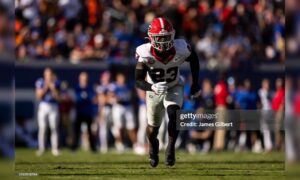By Matthew Marczi
It is no secret that the Pittsburgh Steelers were not completely satisfied with the performance of their running game in 2012. That is partly why two of the running backs from last year are now gone, and why they spent a second round draft pick this past April to bring in another player at the position with a high pedigree who has a future as a feature back.
I am talking, of course, about Le’Veon Bell, whose powerful running behind a poor offensive line during his final season at Michigan State helped make him one of the first running backs off the board in this past draft. However, before he can earn that coveted feature back role, he must first demonstrate an aptitude for pass protection.
As much as the running game may have suffered last season, in part due to numerous injuries within the ranks of the running backs and the offensive line, one area in which the backs did not suffer was in their pass protection duties. In fact, while I’ve not formally done a cross-comparison of all the running back units around the league, I feel comfortable in saying that they ranked among the best in the league collectively with respect to their pass protection.
Referencing Pro Football Focus statistics, the Steelers running backs as a whole ran pass protection duty on 185 snaps during the 2012 season on 751 total passing snaps. In those 185 snaps, they never allowed Ben Roethlisberger (or Byron Leftwich, or Charlie Batch) to be sacked, or even hit. In fact, they gave up just six hurries on the year.
Six running backs share responsibilities for these statistics, and they break down as follows:
| Name | Pass Snaps | Pass Blocking | Blocking % | Hurries |
|---|---|---|---|---|
| Rashard Mendenhall | 46 | 4 | 8.7 | 0 |
| Isaac Redman | 176 | 64 | 36.4 | 1 |
| Jonathan Dwyer | 199 | 56 | 28.1 | 1 |
| Baron Batch | 67 | 23 | 34.3 | 1 |
| Will Johnson | 156 | 27 | 17.3 | 2 |
| Chris Rainey | 107 | 11 | 10.3 | 1 |
Not surprisingly, Rashard Mendenhall and Chris Rainey were called upon to pass protect the least, both in total and in terms of percentage of passing snaps. Yet, they combined to give up just one hurry in 15 snaps, with Rainey logging 11 of those and giving up the hurry.
Isaac Redman has long had a reputation of being a strong pass protector. Even as a rookie, his pass protection was commended in one-on-one, isolation situations. However, he struggled to read defenses and identify blitzers, which contributed to him watching the team from the sidelines on the practice squad his first year.
Thus, it is not surprising that he pulled down the most snaps in pass protection, both in number and in percentage. In fact, among running backs with 50 or more snaps in pass protection, he ranked as having the ninth-highest percentage of total passing snaps as a blocker, with former New York Giants and current Indianapolis Colts running back Ahmad Bradshaw topping the list (45.1 percent of Bradshaw’s 337 passing snaps were in pass protection).
It is certainly worth noting that Baron Batch also spent a large portion of his passing snaps in protection, with 23 of his 67 snaps, or 34.3 percent, fulfilling that role. He first made a buzz in his rookie training camp by showing well in the backs on backers drill before tearing his ACL.
Batch came out of the wide open, pass happy Texas Tech offensive scheme run by Mike Leach, where he logged 140 receptions for 1111 yards and five touchdowns in college, so it should not be overly surprising that he came into the league already having a nose for pass protection.
Of course, his production on the field in the NFL obviously did not disappoint, otherwise he would not have drawn so many snaps in protection. In his 23 blocking snaps, he forfeited just one hurry. His pass protection will certainly play in his favor when the final 53-man roster is being written up.
It is also worth noting, especially considering the significant speculation that he could find himself as the odd man out at the running back position, that Jonathan Dwyer excelled in pass protection as well. Just over 28 percent of his passing snaps were in protection, and of his 56 blocking snaps, he forfeited just one hurry.
Indeed, in PFF’s ratings, both Redman and Dwyer tied for third in the league in pass protection with a score of 3.3. Bradshaw, unsurprisingly, was on the top with a score of 6.2, but Washington Redskins running back Alfred Morris was notably second with a score of 3.8, allowing one sack and one hurry on 85 pass protection snaps.
In their Pass Blocking Efficiency metric, Redman topped the list of all backs who played at least 25 percent of a team’s passing snaps with a rating of 98.8. Dwyer was second with a rating of 98.7.
As a unit, the Steelers backs forfeiting six hurries on 185 snaps is exceptional, and amounts to a 96.8 percent success rate. If we use PFF’s metrics, which rate hurries less harshly than sacks, the unit would have a Pass Blocking Efficiency rating of 97.6 (out of 100, of course).
Of all backs with at least 50 pass protection snaps, only five individually topped that mark. Two of them, of course, were Redman and Dwyer. The other three were Morris, Green Bay Packers back Alex Green, and New York Giants fullback Henry Hynoski.
Will Le’Veon Bell be able to match the pass blocking prowess of his fellow running backs? That will be a key question in determining if and when he will emerge as the starting running back for the Pittsburgh Steelers. The pads go on today, so we should start to see what he has in this regard sooner rather than later.







